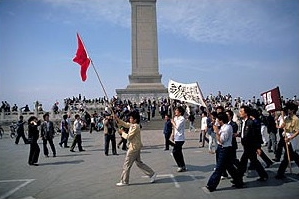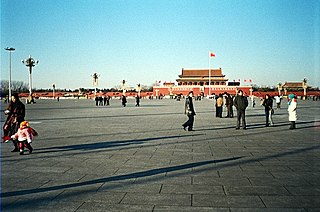
The Tiananmen Square protests, known in Chinese as the June Fourth Incident were student-led demonstrations held in Tiananmen Square, Beijing, China, during 1989. The protests started on 15 April and were forcibly suppressed on 4 June in what is known as the Tiananmen Square Massacre, or in Chinese the June Fourth Clearing or June Fourth Massacre, in which Chinese government troops violently suppressed the demonstrators and those trying to block the military's advance into Tiananmen Square. Estimates of the death toll vary from several hundred to several thousand, with thousands more wounded. The popular national movement inspired by the Beijing protests is sometimes called the '89 Democracy Movement or the Tiananmen Square Incident.
The 1989 Tiananmen Square protests and massacre were student-led demonstrations in Beijing and the government response in 1989.

Chai Ling is a Chinese psychologist who was one of the student leaders in the Tiananmen Square protests of 1989. She is the founder of All Girls Allowed, an organization dedicated to ending China's one-child policy, and the founder and president of Jenzabar, an enterprise resource planning software firm for educational institutions.

The Tiananmen, or the Gate of Heaven-Sent Pacification, is a monumental gate in the city center of Beijing, China, the front gate of the Imperial City of Beijing, located near the city's Central Business District, and widely used as a national symbol.

Han Dongfang is a Chinese advocate for workers' rights.

Ding Zilin is a retired professor of philosophy and the leader of the political activist group Tiananmen Mothers. Ding is the mother of Jiang Jielian, one of the first student protestors killed during the 1989 Tiananmen Square protests and ensuing crackdown.

Carma Hinton is a documentary filmmaker and Clarence J. Robinson Professor of Visual Culture and Chinese Studies at George Mason University. She worked with Richard Gordon in directing thirteen documentary films about China, including Morning Sun and The Gate of Heavenly Peace. She has also taught at Swarthmore College, Wellesley College, MIT, and Northeastern University and has lectured on Chinese culture, history, and film around the world.

The Gate of Heavenly Peace is a 1995 documentary film, produced by Richard Gordon and Carma Hinton, about the Tiananmen Square protests of 1989.

Tiananmen Square or Tian'anmen Square is a city square in the city center of Beijing, China, named after the eponymous Tiananmen located to its north, which separates it from the Forbidden City. The square contains the Monument to the People's Heroes, the Great Hall of the People, the National Museum of China, and the Mausoleum of Mao Zedong. Mao Zedong proclaimed the founding of the People's Republic of China in the square on October 1, 1949; the anniversary of this event is still observed there. The size of Tiananmen Square is 765 x 282 meters. It has great cultural significance as it was the site of several important events in Chinese history.
Hou Dejian, is a songwriter, composer, and singer from Taiwan.
Events in the year 1989 in the People's Republic of China.

Feng Congde is a Chinese dissident and Republic of China Restoration activist. He was as a student leader from Peking University during the Tiananmen Square protests of 1989, which placed him onto the Chinese government's 21 Most Wanted list. He spent 10 months hiding in various locations in mainland China, until he was smuggled out to Hong Kong on a shipping vessel.
The 1989 Tiananmen Square protests and massacre were the first of their type shown in detail on Western television. The Chinese government's response was denounced, particularly by Western governments and media. Criticism came from both Western and Eastern Europe, North America, Australia and some east Asian and Latin American countries. Notably, many Asian countries remained silent throughout the protests; the government of India responded to the massacre by ordering the state television to pare down the coverage to the barest minimum, so as not to jeopardize a thawing in relations with China, and to offer political empathy for the events. North Korea, Cuba, Czechoslovakia, and East Germany, among others, supported the Chinese government and denounced the protests. Overseas Chinese students demonstrated in many cities in Europe, America, the Middle East, and Asia against the Chinese government.

A Heart for Freedom: The Remarkable Journey of A Young Dissident, Her Daring Escape, And Her Quest to Free China's Daughters is an autobiography by Chai Ling (柴玲), one of the student leaders in the Tiananmen Square protests of 1989 in Beijing, China. The book was published in 2011 by Tyndale House, a Christian press based in Illinois.
Defend Tiananmen Square Headquarters was formed on May 24, 1989. The purpose of this organization was to create a strong leadership to lead the student movement.
The catalyst for the birth of the Tiananmen Square protests of 1989 was the death of Hu Yaobang on April 15, 1989. Beginning in late April until June 3 large crowds gathered in Tiananmen Square. During this period a significant amount of money was donated to the student organizations, it was spent on providing food, water and other supplies required to sustain the many thousands of protesters who occupied the square.
The first of two student hunger strikes during the 1989 Tiananmen Square protests and massacre began on May 13, 1989, in Beijing. The students said that they were willing to risk their lives to gain the government's attention. They believed that because plans were in place for the grand welcoming of Mikhail Gorbachev, the General Secretary of the Communist Party of the Soviet Union, on May 15, at Tiananmen Square, the government would respond. Although the students gained a dialogue session with the government on May 14, no rewards materialized. The Chinese Communist Party (CCP) did not heed the students' demands and moved the welcome ceremony to the airport.
The 1989 Tiananmen Square protests and massacre saw a massive redeployment of People's Liberation Army (PLA) troops into and around Beijing. After the declaration of martial law, the Central Military Commission (CMC) mobilized at least 22 divisions from 13 Armies, which converged on Beijing. This force far exceeded the local garrison, with troops being sent in from across China. Altogether, roughly 300,000 troops were involved in the campaign to quell the protests. By their end, the PLA had proven that it was largely willing to enforce party decrees with lethal force. Multiple significant breaches of military discipline occurred after the imposition of martial law. Some cases involved officers or entire units being unwilling to obey directives from farther up the chain of command, others related to the misuse of military equipment, and some were responsible for casualties incurred during the night of June 3. It is unclear when, how, or even if some PLA units received orders to open fire on the protesters, and so knowing whether or not an incident amounts to insubordination is difficult. If the PLA as a whole received orders to use lethal force, CMC chairman Deng Xiaoping must have given his assent to it. CMC vice-chairman and President Yang Shangkun's orders to the Central Military Commission on the 20th of May 1989 explicitly deny troops the authority to use lethal force during martial law, even when their lives are threatened by the protesters. According to Li Xinming's report to the politburo on June 19 however, 10 PLA soldiers did end up dying, along with 13 from the People's Armed Police. For these 23 dead, they inflicted 218 deaths on the protesters, although some sources place this number in the thousands.









